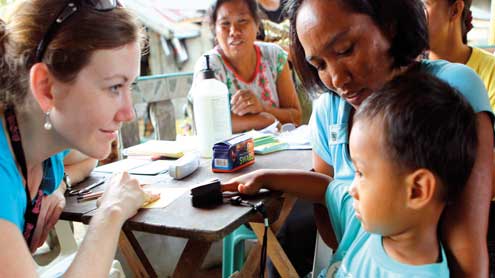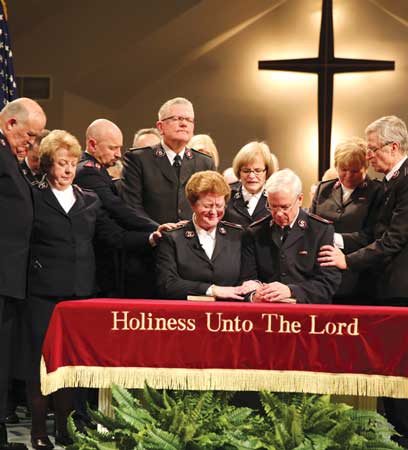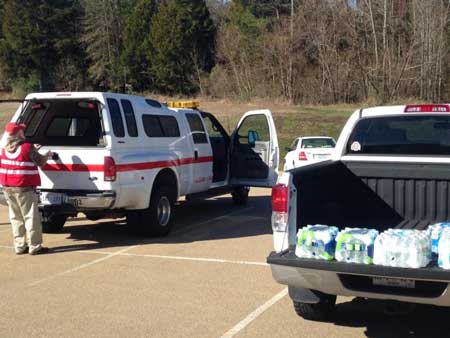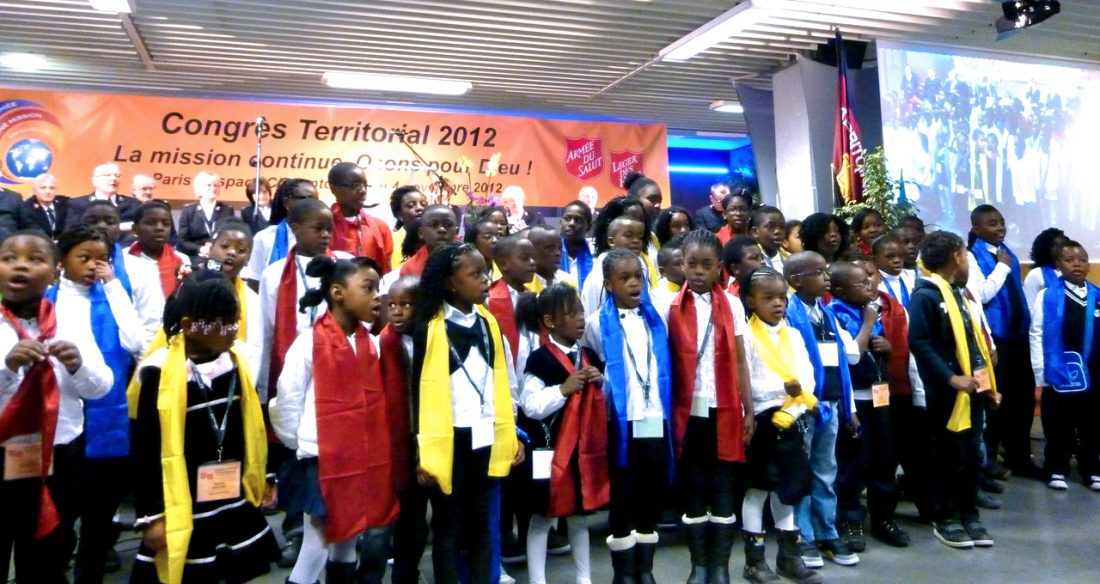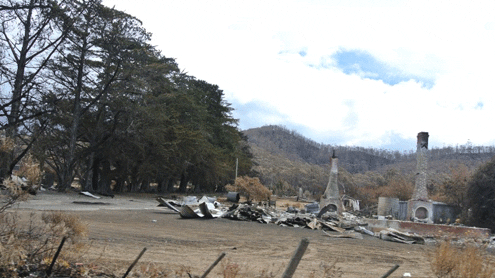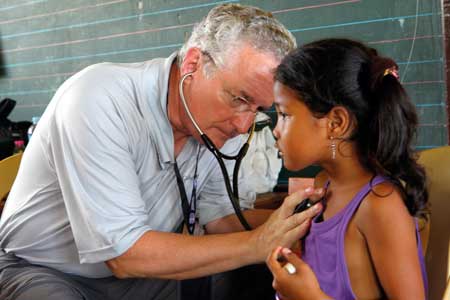
By Major Dean Pallant
As my plane descended into Tacloban City, the region’s vulnerability to the sea was obvious. Tacloban is built on a coastline of inlets, with the airport runway jutting out on a narrow spur of land. The city is built at the top of a funnel of land with nothing between Leyte Island and the west coast of the USA – only thousands of miles of the warm Pacific Ocean, an ideal breeding ground for storms and typhoons.
Days before 8 November 2013, TV and radio forecasters warned a major storm was on the way. The experts spoke of a ‘storm surge’ but many people did not understand this new term. Many drowned in their homes that dreadful morning. ‘If they had told us a tsunami was coming,’ one person told me, ‘we would have known what to expect.’
I landed in Tacloban exactly a month after Super Typhoon Haiyan (known as Yolanda in The Philippines) drowned thousands of people. The death toll is disputed – between 6,000 and 15,000 people. The UN estimates four million people have been displaced and 14 million lives affected. These massive numbers did not affect me as much as seeing family homes and entire communities blown out and washed away. Mile upon mile of destroyed houses, roofs ripped off, millions of palm trees up-ended or stripped to stumps – the sheer scale of the destruction was overwhelming.
Members of The Salvation Army were among the affected people but they were also some of the first to respond. Personnel from Cebu and Manila got to Tacloban as soon as they could to support the Salvation Army corps (church) at Tacloban as its members started to serve their community with what they had. International Emergency Services deployed Damaris Frick, an experienced field officer, from London to support the territorial response and coordinate with the United Nations, the government and other non-governmental organisations (NGOs). Major Drew Ruthven (Australia Southern) and Matthew Beatty (USA Central) soon joined her.
The Salvation Army’s immediate response focused on food and water for the survivors. Thousands of people were airlifted out of Tacloban City and The Salvation Army helped at the airport – day after day, hour by hour – with food, water and pastoral care. It was exhausting work both emotionally and physically in searing heat and stifling humidity.
Getting supplies to the affected area has been extremely difficult but trucks were finally able to drive from Manila to deliver supplies. Warehouse facilities were hard to find but The Salvation Army linked up with the Mormons and logistics/delivery company UPS – an unexpected but highly effective partnership – to move, store and distribute much-needed supplies to affected communities. A judge in Tacloban wanted to help his people and so allowed Salvation Army team members to use his car for a number of weeks. It has air conditioning, which was a real blessing to weary workers!
Partnership has been a key characteristic of the response. Colonels Wayne and Robyn Maxwell, territorial leaders in The Philippines, visited Tacloban with Commissioner Gillian Downer, the International Secretary for South Pacific and East Asia, less than two weeks after the typhoon to give their support and encouragement. The Salvation Army around the world has come together to pray and give financial support to the relief and recovery effort. Thousands of members of the public around the world have given money to The Salvation Army – a global partnership.
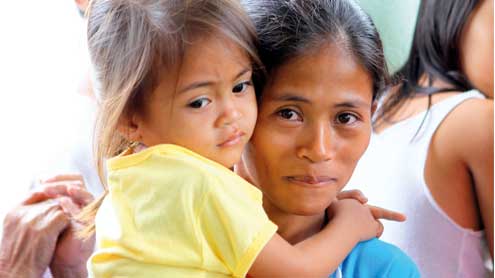
Partnership and cooperation are essential after a disaster. The Salvation Army and the Christian Medical and Dental Associations (CMDA) from the USA partnered together for the first time to provide medical care to people affected by the typhoon. Dr David Stevens, CEO of CMDA, led the first team and partnered with Dr Mirriam Cepe, a Filipino Salvationist medical doctor, who coordinated the Salvation Army health response. Doctors, nurses, officers and corps members all worked together to serve those affected.
In its first three weeks of operation, the team saw 1,495 patients, immunised 942 children and started a dental programme which will operate for a number of weeks – headed by world-renowned oral and maxillofacial surgeon Dr Sam Molind. A total of 2,669 hygiene kits were also distributed.
Dr Stevens, reflecting on the partnership, wrote: ‘It has and will continue to touch many lives one on one, meeting each individual at their point of medical need but more importantly sharing with them the love and compassion of Christ … The local Salvation Army officers working with us did the same as they provided counsel and prayed with many patients. It was [biblical apostles] Paul and Luke, doctors and evangelists, working together. We owe much to the tireless efforts of Colonel Maxwell and his team. They handled logistics and provided Philippine staff to work alongside our health team. There was wonderful synergy that accomplished much more than either group could have done alone.’
When the CMDA team complete its mission, the health ministry to the affected communities will be continued by the Filipino Salvation Army team.
The World Health Organisation (WHO) and Samaritan’s Purse have also partnered with The Salvation Army. Samaritan’s Purse provided thousands of hygiene kits which The Salvation Army teams distributed with health education while WHO supplied vaccines for the immunisation programme.
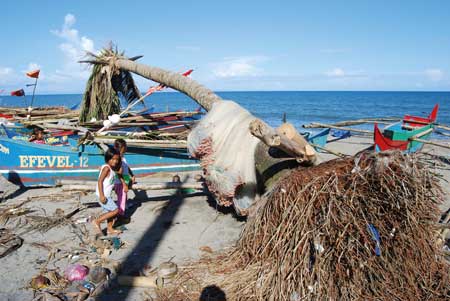
Another characteristic of the response to the typhoon is resilience. The people of The Philippines are sadly well experienced in coping with natural disasters but their resilience to this major catastrophe is amazing.
For example, as I lay on the hard floor at 5 am after a fitful night with little sleep – none of our team had beds – I heard the sound of banging. I looked out the window to see a man repairing his roof. He was not waiting for help but getting on with it at the crack of dawn.
Throughout my visit I witnessed many examples of resilience. Fishermen told me they were already back on the killer sea catching fish each morning despite some of their boats being destroyed. Electricians climbed recently erected poles, trying to restore power (in mid-December there was still no running water or electricity). A school teacher proudly showed me her school, which was open just three weeks after the deadly storm, despite a collapsed classroom and trees strewn around the playground. Market traders were back on the roadside with tables of fresh vegetables and fruit. Traffic jams were starting again in Tacloban as fuel prices returned to normal – the cost of a litre of fuel reached US$10 in the days after the typhoon.
Despite superficial signs of normality, the road to recovery will be long and hard. Understandably there are deep emotional scars. I attended Sunday worship at the Salvation Army corps in Tacloban. The corps officer opened up the meeting for testimony, encouraging his little flock to thank God and share prayer requests. The emotions were raw: ‘Thank you God I am alive’; ‘Please help me with fears in the night’; ‘Thank you for those who have come to help us’; ‘Please protect us under martial law’; ‘Help my spiritual life to deepen through this’.
Many of the poorest people are coconut farmers who will be hit hard for years to come. Palm oil is a valuable product and a mature palm tree produces a crop every six to eight weeks. However, it takes five to ten years for a palm tree to reach maturity. I saw thousands and thousands of trees upended – the farmers’ income will take years to recover.
The Salvation Army is committed to partner with the people of Tacloban and other affected communities across The Philippines for years to come. One of its strengths is that it is not a foreign NGO – The Salvation Army has been serving the people of The Philippines since the 1930s and will continue to serve for years to come.
As time passes the focus in the typhoon-hit areas will move from relief work to longer-term recovery and development. Initial discussions about the best ways in which The Salvation Army can help communities to recover have already started. Many creative and interesting options are on the table.
Typhoon Haiyan will never be forgotten by the millions of people whose lives were changed forever by a storm that lasted less than eight hours – but the partnerships between The Salvation Army, other agencies and local communities will ensure that recovery will come and many lives will be rebuilt.
Major Dean Pallant is Under Secretary for Programme Resources and International Health Services Coordinator at The Salvation Army’s International Headquarters
This article was first published in All the World, The Salvation Army’s international magazine.











